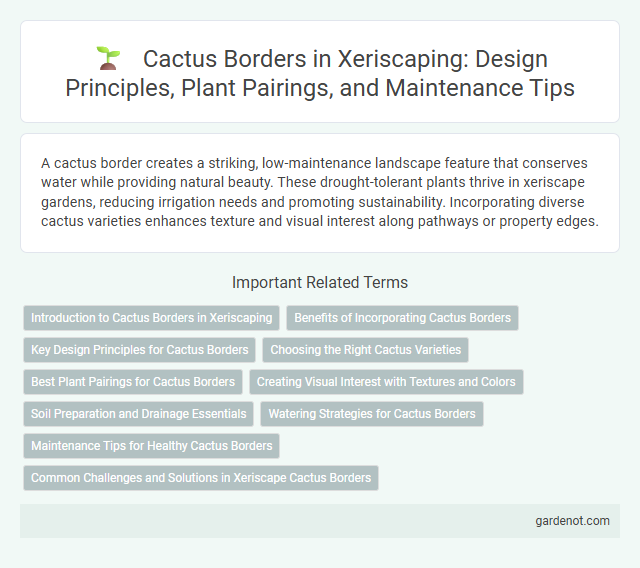A cactus border creates a striking, low-maintenance landscape feature that conserves water while providing natural beauty. These drought-tolerant plants thrive in xeriscape gardens, reducing irrigation needs and promoting sustainability. Incorporating diverse cactus varieties enhances texture and visual interest along pathways or property edges.
Introduction to Cactus Borders in Xeriscaping
Cactus borders are a key element in xeriscaping, offering drought-resistant and low-maintenance landscape solutions. These borders utilize various species of cacti, such as prickly pear and barrel cactus, to create natural barriers that conserve water and reduce soil erosion. Incorporating cactus borders enhances garden aesthetics while promoting sustainable water usage in arid and semi-arid climates.
Benefits of Incorporating Cactus Borders
Cactus borders enhance xeriscape gardens by providing drought-resistant, low-maintenance barriers that conserve water and reduce soil erosion. These resilient plants attract pollinators such as bees and butterflies, promoting local biodiversity while requiring minimal irrigation. Incorporating cactus borders also adds unique texture and visual interest, creating natural security with their spiny structure.
Key Design Principles for Cactus Borders
A well-designed cactus border emphasizes drought tolerance, incorporating diverse species with varying heights and textures to create visual interest and natural flow. Strategic spacing allows for healthy growth while minimizing water usage, aligning with xeriscape principles. Utilizing mulch and rock accents enhances moisture retention and adds to the aesthetic appeal of the cactus border.
Choosing the Right Cactus Varieties
Selecting the right cactus varieties for a xeriscape border involves considering factors like climate tolerance, growth habits, and aesthetic appeal. Popular choices include prickly pear (Opuntia) for its vibrant pads and flowers, golden barrel cactus (Echinocactus grusonii) for its striking spherical shape, and cholla (Cylindropuntia) for its unique branching structure. These varieties thrive in arid conditions, require minimal water, and provide diverse textures and colors to enhance low-water landscaping.
Best Plant Pairings for Cactus Borders
Ideal plant pairings for cactus borders include drought-tolerant succulents such as agave, aloe, and yucca, which complement the spiky textures and require minimal water. Ornamental grasses like blue fescue or muhly grass add soft movement and contrast to the rigid cactus forms while thriving in xeriscape conditions. Incorporating flowering perennials such as lavender or desert marigold enhances color diversity and attracts pollinators, promoting a sustainable and visually appealing xeriscape border.
Creating Visual Interest with Textures and Colors
Cactus borders enhance xeriscape gardens by introducing a variety of textures and vibrant colors that create dynamic visual interest. Combining spiky, smooth, and ribbed cactus species in contrasting shades of green, blue, and purple draws the eye and breaks monotony. Strategic placement of flowering cacti adds bursts of color, complementing the structural forms and enriching the overall landscape design.
Soil Preparation and Drainage Essentials
Preparing soil for a cactus border requires well-draining, sandy or gritty soil mixed with coarse sand and organic matter to prevent water retention. Effective drainage is crucial; incorporating gravel or decomposed granite beneath the planting area ensures excess water flows away from roots, reducing the risk of rot. Maintaining a slightly acidic to neutral pH (6.0-7.0) supports optimal cactus growth in xeriscape landscapes.
Watering Strategies for Cactus Borders
Efficient watering strategies for cactus borders include deep, infrequent irrigation to encourage strong root growth and drought tolerance. Drip irrigation systems minimize water waste by delivering moisture directly to the soil, reducing evaporation. Mulching around cactus borders retains soil moisture, moderates temperature, and suppresses weed growth, enhancing water conservation in xeriscape designs.
Maintenance Tips for Healthy Cactus Borders
Regularly inspect cactus borders for pests such as scale insects and mealybugs, removing them promptly to maintain plant health. Ensure well-drained soil and avoid overwatering to prevent root rot, a common issue in xeriscape environments. Prune dead or damaged pads carefully to promote air circulation and encourage robust growth within the cactus border.
Common Challenges and Solutions in Xeriscape Cactus Borders
Cactus borders in xeriscape landscapes often face challenges such as inadequate soil drainage, which can lead to root rot, and inconsistent watering that stresses plants. To mitigate these issues, incorporating well-draining soil mixes with sand or gravel and establishing a deep, infrequent watering schedule promotes healthy growth. Protective measures against pests like mealybugs include regular inspection and natural insecticidal treatments to maintain vibrant, resilient cactus borders.
Cactus border Infographic

 gardenot.com
gardenot.com